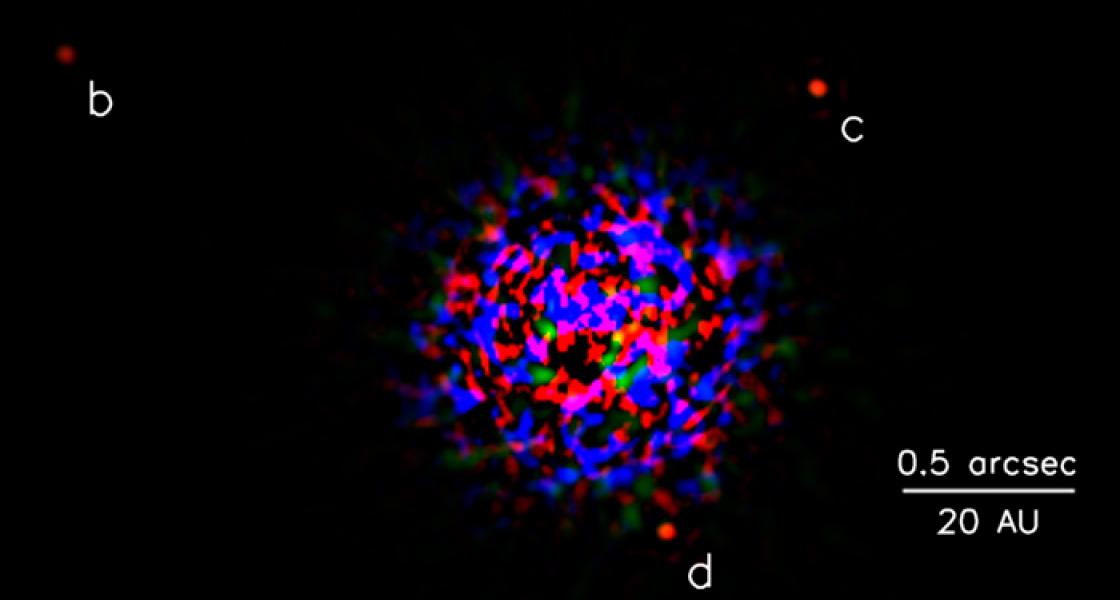Most known extrasolar planetary systems comprise planets whose orbits vary wildly from the nearly circular ellipses found in our solar system. This wide variation in eccentricity is thought to occur when large gas planets interact with each other, causing gyrations in planetary orbits, planet migrations toward and away from the central star, and even the ejections of planets out of the star system. These interactions are known as planet-planet scattering. While this mechanism is important, it can’t be the whole story because it doesn’t explain the architecture of the Solar System.
In the Solar System, eight planets happily circle the Sun. Their orbits are not only almost circular, but they are also close to being in the same plane. For some time, astrophysicists have theorized that the orbits of the giant gas planets (Jupiter, Saturn, Uranus, and Neptune) are a result of interactions with the Kuiper belt, a disk of debris (including Pluto) left over from planet formation. In theory, past planet-debris interactions acted to stabilize our outer four gas planets. They were also responsible for the resonance observed between the orbits of Neptune and Pluto.
Recently Fellow Phil Armitage and colleagues from CU and Google decided to investigate whether planet-debris interactions were unique to our solar system, or whether a similar mechanism has been at work luring outer planets in other star systems into stable elliptical orbits. The researchers created a monster simulation (which took months to run on Google computers) to find out more about planet-debris interactions. They thought they might discover that ours wasn’t the only star system molded by both planet-planet scattering and planet-debris interactions. After all, in September of 2008, the Keck Telescope had captured an image of a far-away star surrounded by three outlying planets — most likely with near circular orbits. This star system, known as the HR 8799 Planetary System, is shown in the figure above.
Armitage and his colleagues found that planetary systems with circular orbits did not occur when planet-planet scattering was the only process at work. In that case, planets ended up with wildly variable orbits that closely matched those of many extrasolar planets observed thus far. However, when the researchers added a disk of debris out past where planets would normally form, the results were surprising.
The outcome of the simulated orbits when a debris disk was present depended on the total mass of the outer planets. If the total mass of the outer planets was more than about twice the mass of Jupiter, the simulated planetary orbital patterns weren’t much different from those due to planet-planet scattering. However, if the total mass of the outer planets was roughly equal to that of Jupiter, the interactions of planets with the debris disk led to most of the planets ending up in nearly circular orbits. Many of these systems also evolved into resonance, where the orbital periods of the planets would be in ratios of 1:2, 1:3, etc. A similar resonance can be seen with three of Jupiter’s moons. However, the resonance between the Jovian moons is caused by tides from the planet rather than interaction with the Kuiper belt.
Still, there are similarities. As Armitage says, "If we see resonant planets or moons, we can be sure that there’s some slow process at work that tends to move the planets or moons around." He says that the reason most extrasolar planets we’ve seen so far don’t have circular orbits is that most of them are also close to their star, where there’s little debris to affect them.
However, once we’re able to observe planets as least as far away from their stars as Jupiter and Saturn are from the Sun (5–10 A.U.), astronomers will likely find many more planets with circular orbits, according to Armitage. The reason is simple. If there’s a debris disk left over from planet formation, it will likely be found on the outer edges of the planetary system. From there, its sphere of influence will only encompass the outer planets. Thus the explanation for why the inner planets of our star system (and others like it) have nearly circular orbits awaits further study. - Julie Phillips



 The Physics Frontiers Centers (PFC) program supports university-based centers and institutes where the collective efforts of a larger group of individuals can enable transformational advances in the most promising research areas. The program is designed to foster major breakthroughs at the intellectual frontiers of physics by providing needed resources such as combinations of talents, skills, disciplines, and/or specialized infrastructure, not usually available to individual investigators or small groups, in an environment in which the collective efforts of the larger group can be shown to be seminal to promoting significant progress in the science and the education of students. PFCs also include creative, substantive activities aimed at enhancing education, broadening participation of traditionally underrepresented groups, and outreach to the scientific community and general public.
The Physics Frontiers Centers (PFC) program supports university-based centers and institutes where the collective efforts of a larger group of individuals can enable transformational advances in the most promising research areas. The program is designed to foster major breakthroughs at the intellectual frontiers of physics by providing needed resources such as combinations of talents, skills, disciplines, and/or specialized infrastructure, not usually available to individual investigators or small groups, in an environment in which the collective efforts of the larger group can be shown to be seminal to promoting significant progress in the science and the education of students. PFCs also include creative, substantive activities aimed at enhancing education, broadening participation of traditionally underrepresented groups, and outreach to the scientific community and general public.